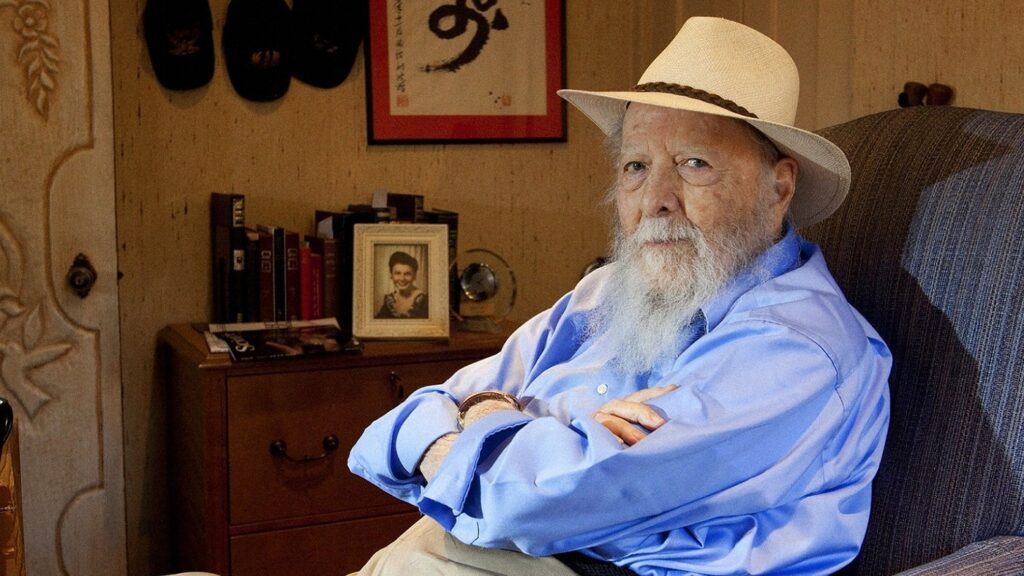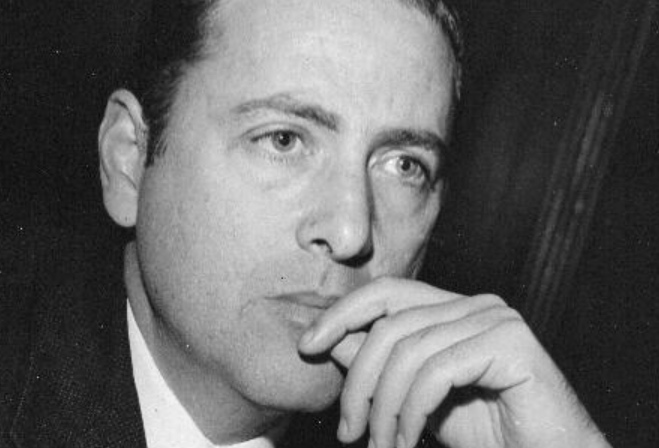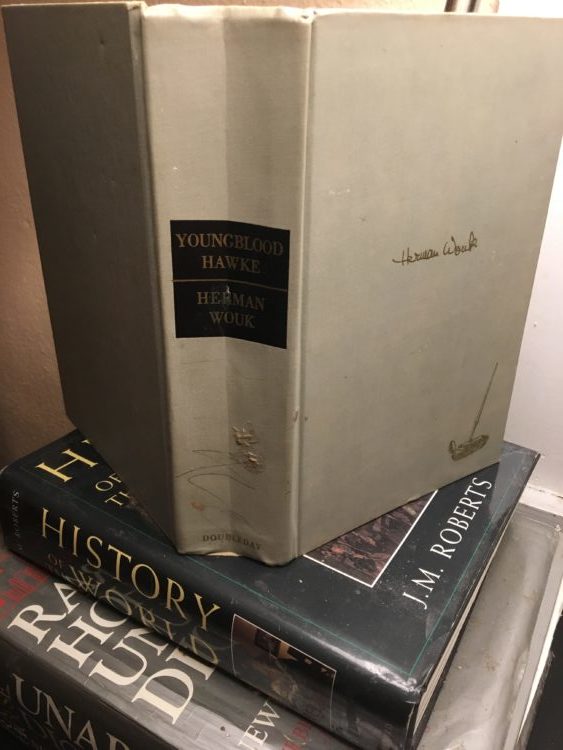The news that Herman Wouk, whose epic World War II novels kept him atop the best seller lists for much of his literary career, died May 17 at the age of 103, led me back more than five decades, and to a spot within inches of the bed where I sit writing this.
There, perched on the Random House Unabridged Dictionary, rests a worn hardcover book. The cover is a faded khaki color. The title, “Youngblood Hawke,” is embossed in faux gold letters on a black background. The copyright date says 1962. It is 780 pages long and weighs two-and-a-half pounds. I know because I weighed it today on a kitchen scale.
I first read “Youngblood Hawke” when I was 12. We weren’t a bookish family, as I recall, but I later learned that a relative had given my oldest brother, Jay, a subscription to Book of the Month Club for Christmas. Like magic, the latest in popular fiction of the 1960s would arrive at our house in suburban Connecticut.
I must have snuck the book out of my brother’s room, because the next thing I remember is devouring the cream-colored pages. Over several days, I stayed up past my bedtime, burrowed under my blanket, reading by flashlight so my mother wouldn’t catch me, struggling to hold the tome upright. Years later, one of my daughters would call the practice "sneak reading.”
I have told this story so many times — to my wife and children, to siblings and friends, in seminars and workshops, in essays, and during a 2002 speech at a writers’ conference that was later published on Poynter Online. Writing about it has become second nature, or, I fear as I retell it here, a type of self-plagiarism. (To counter that literary offense, I have tried to be clear below about sourcing. And at the end, I offer some of the concrete writing techniques evident in "Youngblood Hawke.")

Wouk’s death, which came 10 days before his 104th birthday, has resurfaced this oft-told tale about how reading “Youngblood Hawke” made me a writer — or at least someone determined to write. But it has also helped me understand the value of the craft lessons I learned from a novelist who was beloved by his readers, though not always treated kindly by critics.
"Youngblood Hawke” is a bildungsroman about a young man who leaves his time in the Navy and his life in rural Kentucky to become a novelist in New York City. Through the rise-and-fall journey of the main character, the book also explores the internal world of writing, and the tug-of-war between art and commerce that can cause artists to lose their way. It launches this epic journey with a question that stumped a lost-feeling 12-year-old boy reading by flashlight under his covers:
Have you ever known a famous man before he became famous?
Wouk follows with an answer that offers a morsel of connection, and hope:
It may be an irritating thing to remember, because chances are he seemed like anybody else to you.
In just two sentences, Wouk telegraphed the book’s tension — someone ordinary might one day became a luminary — and grabbed to my childish soul.
I was a scrawny, uncertain kid, and felt ordinary at best. My father had died two years earlier, at 45, leaving a wife, six children, and a mountain of debt. He was a charismatic salesman, and an alcoholic who couldn’t quit drinking, a smoker who wouldn’t quit smoking, and a man who refused to take his medicine despite a series of strokes. If all this made me less-than-ordinary, it didn’t occur to me at the time. Mom, my older siblings, and the charity of our Catholic Church sustained us, but a sense of shame clouded my life.
Perhaps that’s why Wouk’s promise of ordinariness transformed appealed to me. But it was the novel’s second paragraph that really seized my imagination and led me on a lifetime journey of reading and writing, and a search to understand how great writing and writers are made:
The manuscript loomed on the desk between the two men, a high pile of torn and dented blue typing-paper cartons. The yellow labels on the boxes had been scrawled over with thick red crayon, Alms for Oblivion, Part 1, Part 2, Part 3. Two of the boxes, overstuffed with manuscript, had split open. Dog-eared dirty sheets of typewritten manuscript showed through, mostly white, with sprinklings of yellow and green. Waldo Fipps had never seen a larger or more untidy manuscript—or for that matter, a larger and more untidy author.

Wouk won the Pulitzer Prize for fiction in 1952 for his riveting naval drama “The Caine Mutiny,” which went on to become one of the most famous movies of the 20th Century, and a meme unto itself. In “Youngblood Hawke,” set in a span of years around 1950, Wouk has his main character win a Pulitzer for a war novel.
But through the prism of decades as a reporter, writer and writing coach, what I still marvel at is how Wouk created the image of a writer- and man-in-progress with vivid and specific details: The color of the typing-paper cartons; the yellow labels; the thick red crayon and untidy manuscript pages; the ridiculous name, Waldo Fipps, of the man who would become editor to the neophyte Hawke. The details were rich with promise, and held the aura of romance, as did the descriptions of Youngblood Hawke’s impoverished boyhood, the long, solitary nights he spent crafting his prose at an ink-stained desk, his illicit affair with an older married woman, and his doomed relationship with the indispensable copy editor who was the true love of his life.
Some 20 years ago, I stood before about 600 people in an amphitheater at Boston University, at the venerable Aboard the Narrative Train conference hosted by Mark Kramer. I began my speech with a question:
Can you remember the book that made you want to be a writer?
I can.
It’s “Youngblood Hawke,” a bit of a potboiler about a young writer’s rise and fall, based on the life of Thomas Wolfe. That’s (novelist) Thomas Wolfe of “Look Homeward, Angel” and “You Can’t Go Home Again” — not (New Journalism’s) Tom-“The Right Stuff”-and-“The Kandy-Colored Tangerine-Flake Streamline Baby” Wolfe.
Wouk clearly drew inspiration from Wolfe, a southern novelist who wrote his way out of the mountains of North Carolina to the halls of Harvard. Youngblood Hawke was a rough-hewn young man from Kentucky coal country who wrote his way to the apex of the literary world, Broadway and Hollywood. Both his personal and literary lives burned like a Fourth of July sparkler, bright and hot and extinguished way too soon, leaving only the smoking memory of their incandescence. Wouk’s story is a romance, but this one ends badly with the hero’s early death, at 33, burned out by working too hard and drinking too much.
Ding. Ding.
I said this to the audience at Narrative Train:
By the time I finished reading ‘Youngblood Hawke,’ my life was changed. I would be a writer, someone like him, a poor kid who would become rich and famous and pursued by women — although back then I wasn’t exactly sure what I would do if caught. Most of all, I would tell stories that would keep other people up late at night, unable to stop turning the page.
That, to me, is the essence of narrative’s power. It’s what draws all of us here this weekend — the love of narrative’s trance and the passion to weave the spell ourselves by telling stories…
(But) how do you do it? That was my question when I set down that copy of “Youngblood Hawke.”
I wasn’t sure, but back then I was convinced the answer lay in fiction. The problem was I could never find a classified ad for “Best Selling Novelist. Will Train.”
I began writing stories in high school, dreadful things, went off to college, spent a lonely year as a Peace Corps volunteer in Africa, and returned home broke and jobless.
At the Narrative Train conference, I picked up the story:
That all changed in the summer of 1972. Through a friend, I got a tryout with The Milford Citizen, a small daily in a New Haven suburb. Around town, it was known as “The Shitizen.” The city editor, understandably, was dubious. I had no experience, no clips, not even (gasp) a journalism degree. But he gave me four-paragraph wire story about a local man who had been found dead in the Sinai Desert. Later, they told me they expected me to call up the funeral home, get a quote from the relative, and rewrite the wire story. Two takes. Tops.
But all those years of reading novels and short stories since “Youngblood Hawke” had paid off: How the hell does a guy from Milford, Connecticut, end up dying in the Sinai desert?
The answer was “Death in the Desert,” an opus that not only appeared on the front page of the Sunday Citizen — it was the entire front page. …
Based on extensive interviews with the dead man’s friends, family and co-workers, and a ton of library research, my first publication was produced in a white heat, a caffeine-fueled marathon of writing and rewriting. By the time it was done, I was hooked.
“Death in the Desert” was by no stretch of the imagination the kind of artful writing that Youngblood Hawke, or Herman Wouk, his maker, created. But I was doing what I had dreamed of as a child sneak-reading a purloined book. I wasn’t famous and I certainly wasn’t rich, but I was telling stories and getting paid for it. My path was set.
I eventually did go to journalism school. And over the next 45 years, I continued to tell stories as a newspaper reporter and freelance magazine writer. I wrote short stories (still do), and published a few, mostly in obscure literary journals, two newspaper serial novels with my wife, Katharine Fair, finished an unproduced play and screenplay, and collected a shoebox of rejection slips along with more than a dozen awards. Now retired from journalism and teaching, I still do some coaching. I haven’t written my “Youngblood Hawke,” though I do have a banker’s box jammed with the untidy manuscript of the World War II novel that I hope to finish — before my 104th birthday.
Wouk, it should be noted, was working on another book when he died, his literary agent told The New York Times, although he wouldn’t reveal what it was about.
“A writer,” the Nobel Laureate Saul Bellow said, “is a reader who is moved to emulation.” I realized, re-reading “Youngblood Hawke,” that it was the fallen hero’s addiction to words and to the work and to the growing piles of pages he produced that held its greatest appeal, and that holds me to my laptop and printouts this day.
Upon news of Herman Wouk’s death two weeks ago, I whispered words of thanks for the inspiration and education, and for moving me to try to emulate his grasp of the human condition through the power of words.
Narrative Lessons from 'Youngblood Hawke'
“The New Journalism,” the classic anthology edited by Tom Wolfe and E.W. Johnson, introduced many nonfiction writers to the names of devices that had been borrowed from Balzac, Dickens and other literary realists of the 19th century. But even if I didn’t know the terminology, I had long before absorbed the techniques by osmosis reading “Youngblood Hawke,” and tried to model them in my own narrative writing. Chief among them:
Character. If the writer’s task, as Joseph Conrad put it, was “before all” to “make you see,” Herman Wouk was a master of visualization. Here he is on page 5 describing Hawke’s first encounter with the owner of the house that would publish Hawke’s novel, “Alms for Oblivion.” It paints a portrait in 88 words:
Take an ostrich egg, color it fleshy-gray, ink small shrewd features on it, attach a pair of large ears, and you have a fair likeness of what confronted Youngblood Hawke from behind the desk of Jason Prince. The egg hung between broad gray-clad shoulders, peering suspiciously upward. Very long powerful arms clutched a typewritten contract on an otherwise empty desk, the more strikingly empty because the desktop was a slab of glass, allowing a view of a huge empty leather wastebasket underneath, and of Mr. Prince’s lolling legs.
But Wouk could just as easily sketch a minor character Hawke encounters in Paris with a few brushstrokes, as is the case deeper into its 26 chapters of a writer who competed with Hawke for the attention of the literary world and his mistress. Wouk eviscerates him in just 38 words:
He is a physical wreck. He is a gross slob, a red faced fat little fellow with purple veins in his nose. He wears a dirty shirt without a tie, and the café vestments, trench coat and all.
Scene by scene construction. Wouk unspools Hawke’s life, world and demise in a series of elaborate set pieces, built upon scenes replete with characters, settings, dialogue and description. They open in the middle of the action and end with a flourish or a poignant moment. One of my favorites concludes on page 339 when the author has gone home to Kentucky to carve a play from a novel and, desperate to stave off bankruptcy, works to the point of exhaustion. His mother finds him “fast asleep in the chair at his desk, his head on his arms, his right hand and his forearm smeared with ink.”
Scenes take the reader to the South Pacific atolls where Hawke scrapes runways for fighter jets during World War II; his hometown in coal country Kentucky where he made terrifying runs in laden trucks and suffers the brain injury that will lead to his premature death and where his “Mama” schemes to win back her birthright of valuable land and, eventually, to Broadway, Hollywood, Europe, and lastly to a money-sucking Manhattan brownstone with a built-in elevator that he struggles to remodel with royalties diminished by unwise investments. Each place is peopled with characters I don’t have to consult the book to remember: Hawke, a hulk of a man with a shock of unruly hair and a syrupy Southern drawl; his snobby, jealous editor; the no-nonsense copy editor who becomes his friend and the true love — one that will elude him in favor of the older married woman who becomes his mistress, his stubborn and fiercely protective mother and devoted sister; and the vulturous agent who bargains with competing houses, wielding a phone in each hand.
Dramatic vs summary narrative. While scenes reveal the story in real time, Wouk also skips past days, nights and years, sometimes in a single passage or paragraph, to move the story along.
Dialogue. In “Hawke,” people talk to and past each other. Like the best nonfiction writers, Wouk’s character have distinct voices that reveal their character, motives, dreams, and secrets. Dialogue can move a story along, keep it from bogging down, and is the glue that holds a scene together. In my narratives, I tuned into my story subjects and, with the help of a tape recorder, captured dialogue.
Details. Wouk had an eye, an ear and a nose attuned to the quotidian details that bring a story to life:
the air in the cubicle was gray with cigar smoke…
(a) worn cheap pen…
that not war, not illness, not poverty, not lovemaking not celebrity had succeeded in stopping…
From Central Park, a soft breeze carried a morning smell of dewy green leaves.
To the five senses, I learned to add a sense of people, a sense of place, a sense of drama and a sense of time.
Point of view. Wouk writes in third person, except for letters Hawke and other characters write that summarize and dramatize events or convey the nature of relationships. It was a good introduction for a profession where first person was frowned upon and an editor once said, “The reader doesn’t care what YOU think.”



